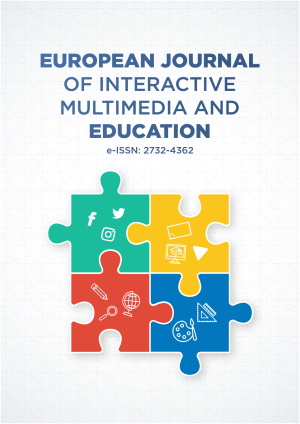Research Article
Multisensory strategies to foster autonomous language learning through digital landscapes
More Detail
1 Universidad Nacional, Heredia, COSTA RICA* Corresponding Author
European Journal of Interactive Multimedia and Education, 6(1), January 2025, e02503, https://doi.org/10.30935/ejimed/16045
Submitted: 04 October 2024, Published: 25 February 2025
OPEN ACCESS 222 Views 108 Downloads
ABSTRACT
This research explores the integration of multisensory strategies in digital learning landscapes to enhance autonomous language learning. Drawing on theoretical foundations such as multisensory integration, learning strategies, and autonomy, the study investigates how digital platforms that engage multiple senses can address the challenges of autonomous online learning, particularly for English language learners. The research focuses on English teachers in the Pedagogical Praxis module of a master’s program, examining their experiences with a multisensory digital landscape designed to foster self-directed learning. The study employed a quantitative research approach, collecting data via surveys to evaluate the impact of multisensory design on learner engagement, language proficiency, and autonomy. Findings indicate that participants experienced higher levels of engagement, improved comprehension, and increased motivation through the multisensory digital landscape. While the majority of respondents reported positive outcomes, minor challenges related to self-management and technical difficulties were noted. Overall, the study highlights the potential of multisensory digital learning landscapes to support autonomous language learners and offers insights into how these strategies can be further refined to maximize educational impact.
CITATION (APA)
Saborío-Taylor, S. (2025). Multisensory strategies to foster autonomous language learning through digital landscapes. European Journal of Interactive Multimedia and Education, 6(1), e02503. https://doi.org/10.30935/ejimed/16045
REFERENCES
- Aja, S. N., Eze, P. I., Igba, D. I., Igba, E. C., Nwafor, C. C., & Nnamani, S. C. (2017). Using multi-sensory instruction in managing classroom for effective teaching and learning. International Journal of Applied Engineering Research, 12(24), 15112–15118. https://www.ripublication.com/ijaer17/ijaerv12n24_163.pdf
- Fadeev, A., & Milyakina, A. (2021). Multisensory learning environments. SHS Web of Conferences, 130, Article 02003. https://doi.org/10.1051/shsconf/202113002003
- Feitosa, G., Miyahara, R., & Alves, V. (2022). Multisensory integration approach, cognitive domains, meaningful learning: Reflections for undergraduate nursing education. Revista da Escola de Enfermagem da USP, (56), Article e20210381. https://doi.org/10.1590/1980-220x-reeusp-2021-0381
- Freepik. (2024). Multicultural and interrratial community. Amigos de ángulo bajo en sillas con burbujas de chat [photograph]. https://www.freepik.es/serie/5965437/2
- García-Tudela, P. (2021). Los paisajes de aprendizaje como una herramienta para atender a la diversidad: Análisis cualitativo de propuestas didácticas [Learning landscapes as a tool to address diversity: Qualitative analysis of teaching proposals]. In A. B. Barragán, M. M. Molero, A. Martos, M. M. Simón, J. J. Gázquez, & M. C. Pérez-Fuentes (Eds.), Innovación docente e Investigación en educación: Nuevos enfoques en la metodología docente (pp. 549–557). Dykinson. https://doi.org/10.2307/j.ctv2gz3vbd.52
- Hernández-Silvera, D. I., & Ghilardelli, M. A. (2022). Paisajes digitales de aprendizaje en la universidad huellas vivenciales e inserción comunitaria [Digital learning landscapes at the university: experiential traces and community insertion]. Revista Panamericana de Pedagogía, (35), 135–151. https://doi.org/10.21555/rpp.vi35.2727
- Hernando, A. (2015). Viaje a la escuela del siglo XXI. Así trabajan los colegios más innovadores del mundo [A trip to the school of the 21st century. This is how the most innovative schools in the world work]. Fundación Telefónica. https://www.fundaciontelefonica.com/noticias/record-descargas-viaje-escuela-siglo-21-alfredo-hernando/
- Khairallah, M., Fleonova, O., & Nicolas, M. O. (2020). Understanding students’ resistance to autonomous learning in an L2 English language course at a University in Lebanon. (2020). European Journal of Education, 3(1), 20–38. https://doi.org/10.26417/ejed.v3i1.p18-30
- Kieu, C. Y. (2023). Harnessing linguistic landscapes for language learning: A comprehensive guide (5 key areas of 25 awesome tips). Language Educators Assemble. https://www.languageeducatorsassemble.com/linguistic-landscapes/
- Lavidas, K., Voulgari, I., Papadakis, S., Athanassopoulos, S., Anastasiou, A., Filippidi, A., Komis, V., & Karacapilidis, N. (2024). Determinants of humanities and social sciences students’ intentions to use artificial intelligence applications for academic purposes. Information, 15(6), Article 314. https://doi.org/10.3390/info15060314
- Main, P. (2021). Multisensory learning in the classroom: A teacher’s guide. Structural Learning. https://www.structural-learning.com/post/multisensory-learning-in-the-classroom-a-teachers-guide
- Myréen, S. (2017). Evaluating the role of multisensory elements in foreign language acquisition. International Journal of Social, Behavioral, Educational, Economic, Business and Industrial Engineering, 11(2), 375–378. https://www.theseus.fi/handle/10024/123817
- Olaya, M., & Mora, W. (2022). Exploring autonomous language learning behaviors through video sharing and online discussions in higher education. Colombian Applied Linguistics Journal, 24(2), 187–202. https://doi.org/10.14483/22487085.17827
- Papadakis, S. (2023). MOOCs 2012-2022: An overview. Advances in Mobile Learning Educational Research, 3(1), 682–693. https://doi.org/10.25082/AMLER.2023.01.017
- Papadakis, S., Kiv, A. E., Kravtsov, H. M., Osadchyi, V. V., Marienko, M. V., Pinchuk, O. P., Shyshkina, M. P., Sokolyuk, O. M., Mintii, I. S., Vakailuk, T. A., Striuk, A. M., & Semerikov, S. O. (2023). Revolutionizing education: Using computer simulation and cloud-based smart technology to facilitate successful open learning. In Proceedings of the 10th Illia O. Teplytskyi Workshop on Computer Simulation in Education, and Workshop on Cloud-based Smart Technologies for Open Education (pp. 1–19). https://doi.org/10.31812/123456789/7375
- Pratiwi, D. I., & Waluyo, B. (2023). Autonomous learning and the use of digital technologies in online English classrooms in higher education. Contemporary Educational Technology, 15(2), Article ep423. https://doi.org/10.30935/cedtech/13094
- Thakran, D. (2023). Integrating text, image, and sound with cross-modal learning. Medium. https://medium.com/@thakrandisharth/integrating-text-image-and-sound-with-cross-modal-learning-266e2b65e6ce

 The articles published in this journal are licensed under the CC-BY Creative Commons Attribution International License.
The articles published in this journal are licensed under the CC-BY Creative Commons Attribution International License.